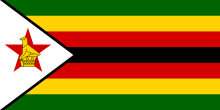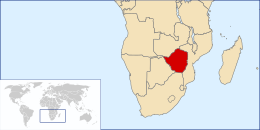 | |
| Educational oversight | |
|---|---|
| Ministry of Primary and Secondary Education Ministry of Tertiary and Higher Education | Dr. Tonderayi Moyo Amon Murwira |
| National education budget (2013) | |
| Budget | $750 million (public, all levels)[1] |
| General details | |
| Primary languages | English, Shona, Ndebele |
| System type | State |
| Established Initiated | 17 October 1982 4 May 1980 |
| Literacy (2023) | |
| Total | 90.7%[2] |
| Male | 91.0%[2] |
| Female | 89.1%[2] |
| Enrollment (2023) | |
| Total | 4 659,993 |
| Primary | 93.9%[3] |
| Secondary | 73.8%[3] |
| Post secondary | 10 %[3] |

Education in Zimbabwe under the jurisdiction of the Ministry of Primary and Secondary Education for primary and secondary education, and the Ministry of Higher and Tertiary Education, Science and Technology Development for higher education. Both are regulated by the Cabinet of Zimbabwe.[4] The education system in Zimbabwe encompasses 13 years of primary and secondary school and runs from January to December.[5] The school year is a total of 40 weeks with three terms and a month break in-between each term.[5]
In 1980, education was declared a basic human right by Robert Mugabe, the leader of the ZANU party, which changed the constitution to recognize primary and secondary public education as free and compulsory.[6] One of Zimbabwe's Millennium Development Goals was to achieve universal education for all students; however, the goal was not achieved as of 2015 due to a public health crisis, economic downturn and inability to afford costs associated with education.[7] The country is currently working toward the Sustainable Development Goal of providing universal and free education to all students by 2030.[8] Zimbabwe had an adult literacy rate of 88% in 2014.[9]
Despite education being recognised as a basic human right in Zimbabwe, in 2017, the Zimbabwean Government did only 77.2% of what was possible at its income level to ensure that the right to education was being fulfilled, categorically, the government's ability to fulfil this right as "bad". This data is collected by the Human Rights Measurement Initiative. The initiative also breaks down the right to education by calculating Primary and Secondary School Enrolment. Keeping Zimbabwe's income level in mind, Zimbabwe is doing only 61.9% of what should be possible at its income level for secondary school enrolment and 92.4 percent for primary school enrolment.[10]
- ^ "Is Zimbabwe's education sector on the road to recovery?". IRIN News. 24 January 2013. Retrieved 10 November 2015.
- ^ a b c UNESCO Institute for Statistics (May 2013). "Adult and Youth Literacy: National, regional and global trends, 1985-2015" (PDF). UNESCO UNESCO Institute for Statistics.
- ^ a b c "The Global Competitiveness Report 2015–2016" (PDF). World Economic Forum. 2015. Retrieved 19 November 2015.
- ^ Chikoko, Vitallis (2008). "The Role Of Parent Governors In School Governance In Zimbabwe: Perceptions Of School Heads, Teachers And Parent Governors." International Review Of Education 54 (2): 243-263. Academic Search Complete. Retrieved November 2015.
- ^ a b "Zimbabwe Education System". Class Base. Retrieved 19 October 2015.
- ^ SACMEQ. Education in Zimbabwe. SACMEQ 2010 ("Education in Zimbabwe - SACMEQ". Archived from the original on 23 March 2009. Retrieved 23 March 2009.). Retrieved 13 September 2011
- ^ "Millennium Development Goal 2". UNDP in Zimbabwe. UNDP. Archived from the original on 21 November 2015. Retrieved 20 November 2015.
- ^ "UNICEF Zimbabwe - Media centre - Sustainable development goals: all you need to know". UNICEF. UNICEF. Archived from the original on 25 September 2018. Retrieved 20 November 2015.
- ^ "Zimbabwe-UNESCO". 27 November 2016.
- ^ "Zimbabwe". Human Rights Measurement Initiative Rights Tracker.